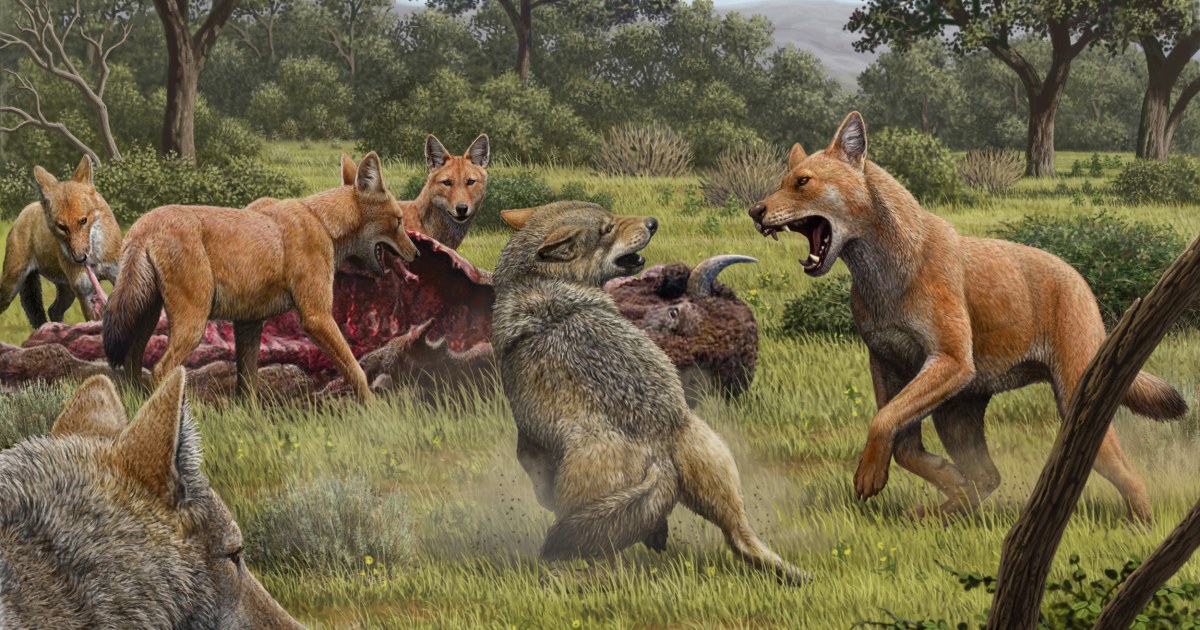
The giant, bone-crushing species of dire wolves that prowled North America until about 12,000 years ago were once believed to be closely related to living wolves.
That depiction was boosted by the HBO television series “Game of Thrones,” which offered what was thought to be a reasonably accurate depiction of the now-extinct animals. They were famously the symbol of House Stark, known for its habitation of the cold northern lands of George R.R. Martin’s mythical world Westeros.
In real life, however, prehistoric dire wolves were not closely related to modern wolves, according to a study published Wednesday in the journal Nature — and it seems they may not have been all that well suited to the cold.
“I certainly don’t think the average dire wolf would have been excited about living in frozen Winterfell,” said Angela Perri, a zooarchaeologist at Durham University in the United Kingdom and the lead author of the study. Winterfell is the ancestral castle of House Stark.
Scientists had assumed dire wolves interbred with gray wolves and other related species, as most living canid (dog-like) species can – including coyotes, jackals and domestic dogs. But the new study reveals dire wolves belonged to an ancient lineage so different from other canids that they did not interbreed.
And if they didn’t interbreed, the researchers argue, dire wolves may have been unable to acquire traits to help them survive in rapidly changing environments at the end of the last Ice Age — about the time they went extinct.
“Dire wolves just didn’t have the ability to adapt, apparently,” Perri said.
Other reasons for their disappearance could be the extinction of many of their prey species in the warming environment, such as horses, camels, and mammoths – possibly some of them at the hands of early Americans, who arrived about the same time. Or it could be that dire wolves fell victim to diseases brought by other wolf and coyotes species that had evolved in Eurasia, she said.
Dire wolf fossils have been found in numerous sites throughout North and South America, mostly in lowlands and in warm climates. Perri said she thinks real-life dire wolves may have had short coats suited to warm weather, rather than the thick shaggy fur portrayed in the fantasy television series.
“I suspect Nymeria, Ghost and Lady [three of the dire wolves in “Game of Thrones”] would look more like one of the more warm-adapted canids, such as dholes,” she said, referring to a species also known as the Asian wild dog that has a short coat.
Perri and her colleagues spent years gathering potential samples of ancient DNA from dire wolf fossils, which have been found at roughly 150 archaeological sites.
Co-author Laurent Frantz, a professor of paleogenetics at Ludwig Maximilian University Munich in Germany, said the study used ancient DNA recovered from the teeth and dense ear-bones of five of the fossils.
By comparing the ancient DNA to genetic material from other canids, they found the dire wolf’s closest living relative was the African jackal, which diverged about 5.1 million years ago, while the closest living wolves diverged about 5.7 million years ago.
“That’s a lot longer than we would have thought,” Frantz said. “We were thinking more in the tens of thousands of years.”
It’s likely the ancestors of dire wolves occupied the Americas before the last Ice Age, and that dire wolves evolved alone over millions of years while the gray wolf (canis lupus) evolved in Eurasia and migrated to the Americas relatively recently, perhaps within the last 50,000 years, he said.
“This is a fascinating result,” said Robert Dundas, a vertebrate paleontologist and professor at California State University, Fresno, who has researched Ice Age mammals and was not involved in the study.
The finding that dire wolves did not interbreed with other species, unlike almost all living canids, could have implications for the causes of their extinction, he said.
“The animals that were able to interbreed … maybe they had some sort of selective advantage,” he said.
Mairin Balisi, a paleontologist at the Los Angeles County Natural History Museum who has worked with dire wolf fossils from La Brea tar pits, said the new research calls for a rethink.
“A lot of the behavior of dire wolves that we have inferred had the implicit assumption that the gray wolf is their closest living relative,” she said. “But this shows that’s not the case.”
Still, it’s likely dire wolves were a pack animal, like gray wolves, and not solitary predators like foxes. One reason is that some of the dire wolf fossils from La Brea show they healed from debilitating injuries like broken bones, which suggests their pack supplied them with food when they could not hunt, she said.
The tar pits at La Brea are a hotspot for dire wolves where more than 4,000 of their fossils have been found since excavations began there in the early 20th century.
“It would be lucky to have a sample size of 10 for a certain species, but we’ve been lucky,” Balisi said. “It was unlucky for the animal, but lucky for paleontologists.”
Source: | This article originally belongs to Nbcnews.com










